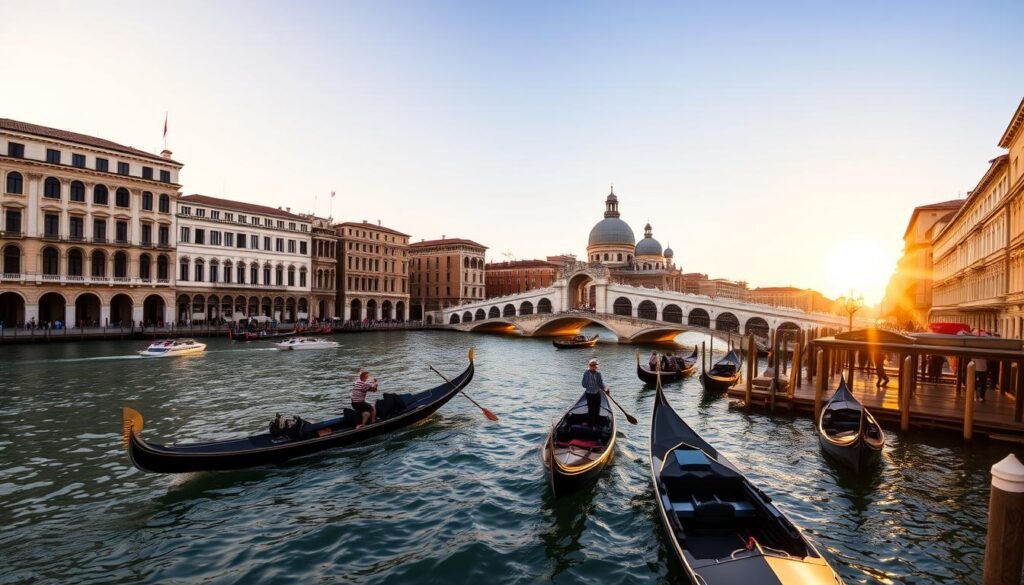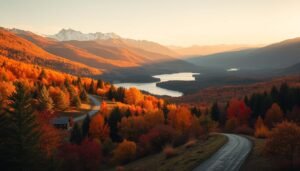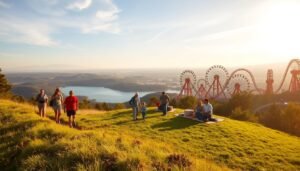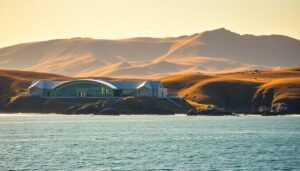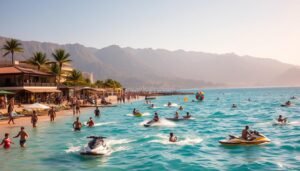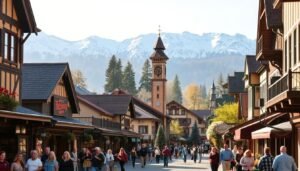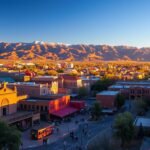Surprising fact: this city spans 117 islands and more than 400 bridges, yet it has no cars and is sailed and walked every day. I arrived drawn by that quiet mobility and the glow of San Marco across the water.
I write this as a friendly, first-person guide that mixes quick tips with small moments that mattered on my trip. I preview the big hitters — St. Mark Square, the Grand Canal, and the Rialto Bridge — and the quiet corners I wander when I need a break.
I explain how getting around works in a car-free place: vaporetti, walking, and the occasional water taxi. This post is meant as a planning home base, whether you have a whirlwind visit or a slower stay. For broader Italy ideas, see best places in Italy.
Key Takeaways
- Venice is navigated by boat and foot; expect many bridges and narrow lanes.
- Hit St. Mark Square, the Grand Canal ride, and Rialto Bridge early for smaller crowds.
- Balance iconic sights with quiet neighborhoods like Cannaregio and secret viewpoints.
- Use the #1 vaporetto for a scenic transit along the main waterway.
- Plan short day trips for colorful Burano and glassblowing Murano.
My essential things to do in Venice right now
I always pick three anchors for a day: one big sight, one neighborhood, and one view. That simple plan keeps the pace gentle and gives room for surprises.
Start with the #1 vaporetto along the Grand Canal. It lays out the city’s shape fast and beautifully. Then wander—Rialto Market at dawn, Libreria Acqua Alta if you love books, or a quiet walk through Cannaregio.
Book these guided visits ahead: Doge’s Palace with the Bridge of Sighs, St. Mark’s Basilica access, and the Jewish Ghetto synagogues. Early Campanile elevators save hours, and late returns to San Marco mean thinner crowds.
For hungry moments, anchor the day with a cicchetti crawl or fresh seafood near the market. If rain arrives, choose La Fenice or the Peggy Guggenheim terrace. On hot afternoons, seek shaded canals and a cold spritz.
- One landmark, one quarter, one lookout — that is my best way to visit without rushing.
Lose the map and let Venice lead me
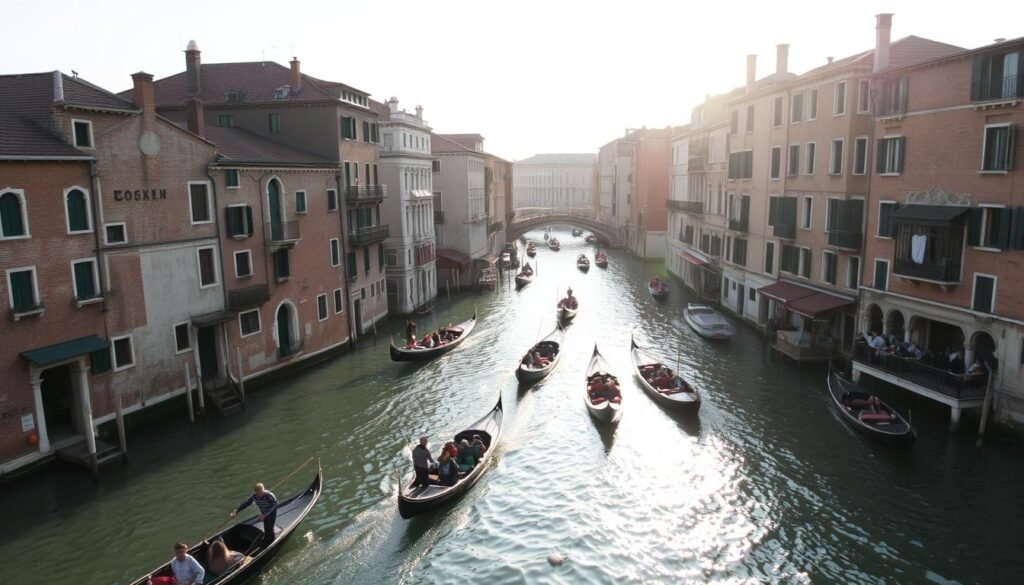
I often let the alleys choose my path, following sound and light rather than a map. The city feels like an instrument; I move when a bell rings or a violin begins.
I switch off navigation and walk by ear, listening for laughter, a single violin, or the gentle splash along narrow canals. Crossing tiny bridges that vanish from memory gives me a small thrill.
I manage my time with a loose return window. That gives me room to wander and still keep plans. I mark a campo, a church facade, or a shop window so I can find the way back when needed.
| When | Why wander | When to head back |
|---|---|---|
| Early morning | Quiet streets, soft light, surprises | None — perfect for getting lost |
| Golden hour | Best photos, music from churches | Stay nearby; plan a short return |
| Night or heavy rain | Limited sights, cozy cafes | Use known landmarks and head back |
Notice more: lift your gaze for rooftop gardens, peek inside open doors, and watch craftspeople at work. I pick a direction by crossing a sestiere or following a small crowd. Often my favorite shots come from these aimless loops.best-time-to-visit-banff
My usual finish: sit on a low wall by the water and watch the day slip by.
Bridges I adore: Rialto, the Bridge of Sighs, and hidden gems
![]()
Bridges stitch the city together, and I follow them like a map of moods.
Rialto Bridge feels timeless to me. The final stone version was finished in 1588 and it remains the widest crossing lined with small shops. I love the classic views up and down the Grand Canal from its center.best-time-to-visit-seattle
I seek the bridge sighs moment at eye level. The Bridge of Sighs links the Doge’s Palace interrogation rooms to the prison. I prefer viewing it from Ponte della Paglia or Ponte de Canonica before walking through the palace.
Ponte dell’Accademia is simple wood that gives my best axis of views, especially near golden hour. For a quieter thrill, I cross Ponte Chiodo, a narrow span with no railings that feels intimate and slightly wobbly.
- Best times: early morning or late light for cleaner backgrounds.
- How I photograph: stand to the side of steps, wait for a clear line, then shoot.
- Navigation tip: use bridges as waypoints from St. Mark toward Dorsoduro.
| Bridge | Why I love it | Best time |
|---|---|---|
| Rialto Bridge | Shops, stone arches, sweeping canal views | Early morning |
| Bridge of Sighs | History, best seen from side bridges | Late afternoon |
| Ponte dell’Accademia & Ponte Chiodo | Golden light views; hidden, intimate crossing | Golden hour / quiet hours |
Each bridge holds a different mood; I return at new hours to feel them all.
Grand Canal magic: riding the #1 vaporetto and a classic gondola ride
![]()
Boarding the #1 vaporetto always feels like opening the city’s long portrait. The line runs the full length of the grand canal and shows the palaces, bridges, and daily life from the water. I often take a southbound trip toward Lido first so I can snag an open-air stern seat for the breeze and sweeping views.
Gliding along the #1 line
I map a favorite leg: near San Marco, past Rialto, out to Lido, then back north. Riding back gives me sights of San Giorgio Maggiore, St. Mark’s edge, and the Rialto Bridge all in one sweep.
Cost note: single vaporetti fares can be pricey (about €9.50), while a 24-hour pass often makes sense if I hop on and off.best-places-to-visit-in-colorado
Choosing a scenic gondola ride the right way
A gondola ride is a slow, intimate glide—very different from a vaporetto transit. I pick quieter side canals over the busiest corridors when I want calm or romance.
- Best times: early morning or after dinner to avoid crowds.
- Tip: time a sunset return for shifting color over the water.
- Etiquette: step only when the gondolier tells you and keep movements steady.
One good ride reorients my whole day—it’s the simplest way I feel how Venice really breathes.
Iconic St. Mark’s: Basilica, Campanile bell tower, and San Marco Square
![]()
Stepping into San Marco feels like entering a gallery built for water and light. The first glimpse inside the basilica is worth planning: sunlight hits the golden mosaics and the space seems to glow.
Inside the basilica and the Museo di San Marco balcony
I time my visit so the mosaics catch morning light. A Museo di San Marco ticket adds the balcony view and a closer look at the original bronze horses.
Riding the Campanile elevator for sweeping views
The Campanile elevator spares stairs. I go at opening or after 5 pm to skip lines. From the top I scan domes, San Giorgio Maggiore, and a patchwork of terracotta rooftops and buildings.best-time-to-visit-puerto-rico
Soaking up the vibe in the square
I linger under shaded arcades, listen for live music, and sip a quick espresso at Caffè Florian when I want history with my coffee. Dress respectfully for the basilica and travel light for easier lines.
| Visit | Best time | Why I choose it |
|---|---|---|
| St. Mark Basilica | Morning | Golden mosaics, quiet entry |
| Museo balcony | Midday | Bronze horses, closer views |
| Campanile | Opening / after 5 pm | Wide city and island views |
“San Marco anchors my visit: power, art, and daily life meet here.”
Doge’s Palace and walking over the Bridge of Sighs
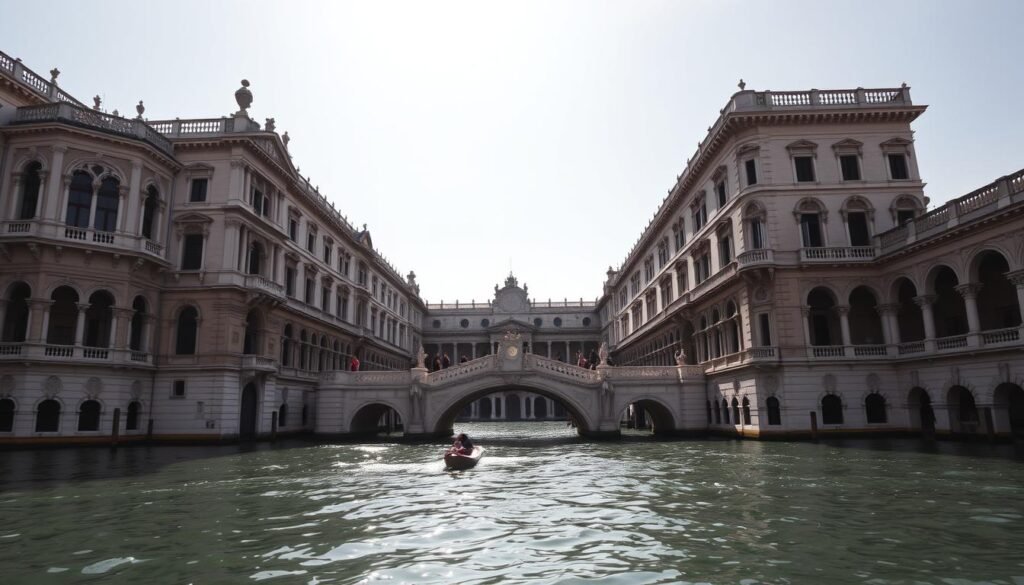
I step through the Doge’s Palace doors expecting marble and ceremony, and I always leave with a human story buzzing in my head.
Palazzo Ducale once housed the Doge, government offices, and the jail. A guided tour is the clearest way to feel the republic’s power inside one building.
The walk across the Bridge Sighs is quieter than I imagined. Through tiny stone windows you glimpse the last view prisoners saw before the cells. When crowded, keep moving so every tourist can pass.
I pace myself through ornate chambers and council rooms. I slow for the grand staircases, pause at paintings that hum with civic pride, and savor corridors that open suddenly onto light.
- Best times: mid-morning or late afternoon for fewer groups.
- Etiquette: move steadily across the bridge; let guides add context.
- Exit tip: head toward the waterfront and view the bridge from Ponte della Paglia.
| Feature | What I watch for | When I visit | Why it matters |
|---|---|---|---|
| Doge’s Palace | Ornate halls, grand staircases | Mid-morning | Shows government, art, and daily power |
| Bridge of Sighs | Tiny windows, final lagoon view | Late afternoon | Connects palace with prison; emotional pause |
| Ponte della Paglia | Exterior bridge view | After tour | Best vantage for photos and reflection |
After I leave, a slow walk along the riva clears my head. The breeze off the lagoon helps the marble and gold settle into a story I can carry.
Seek the best views: rooftops, bell towers, and the Accademia perspective
![]()
I hunt the city’s highest ledges for moments when light stitches buildings together. Good viewpoints reshape a walk into a small story. I pick spots that show how water, stone, and sky meet.
Ponte dell’Accademia at golden hour
I return to this bridge near sunset. The domes of Santa Maria della Salute glow. Boats cut ribbons of light and the view feels endless from the center of the bridge.
San Giorgio Maggiore bell tower looking back to San Marco
I hop across the water and climb the bell tower on San Giorgio Maggiore. From the top I watch san marco and the end of the grand canal. Mornings here are quiet; evenings carry more bustle below.
Rivers of light: terraces along the Grand Canal
Terraces facing the canal give a steady seat for people-watching and light study. I plan my time for mid-afternoon warmth or the drama of sunset. Small shifts—tide, traffic, reflection—change the scene fast.best-places-to-visit-in-december
Tip: skip a tripod. Steady your camera on a railing, use a wider lens, and move with the light.
Art with a waterfront view at the Peggy Guggenheim Collection
![]()
The Peggy Guggenheim Collection feels like a small house museum where world-class modern art meets the Grand Canal. I always split my visit into two acts: a calm gallery stroll, then time on the simple stone terrace watching the water flow by.
Inside, works by Picasso, Dalí, Duchamp, Klee, Magritte, Mondrian, Pollock, and Ernst sit within rooms that once were Peggy’s living spaces. Seeing these pieces at home gives each painting a personal weight.
Light changes the art here. Canalside rooms catch soft reflections, and that natural glow shifts how I read color and texture. The terrace offers wide views of passing vaporetti, gondolas, and workboats.
- I time my visit for late morning or mid-afternoon to avoid crowds.
- I always peek into the small sculpture garden for a quieter moment.
- The gift shop holds meaningful souvenirs—artful, not touristy.
| Feature | Best time | Why I love it |
|---|---|---|
| Galleries | Late morning | Personal scale and light-filled rooms |
| Terrace | Mid-afternoon | Canal views and a place to reset |
| Sculpture garden | Any quiet hour | Calm contrast to passing boats |
“Peggy’s home fuses modern creativity with the old city’s watery heart.”
I often link this stop with a short walk to the Accademia or Salute for more art and strong views of the city. The mix of modern work, a small garden, and a terrace beside the canals makes the Guggenheim my favorite pause when I need a gentle, artful reset.
Feel local rhythms in Cannaregio and the historic Jewish Ghetto
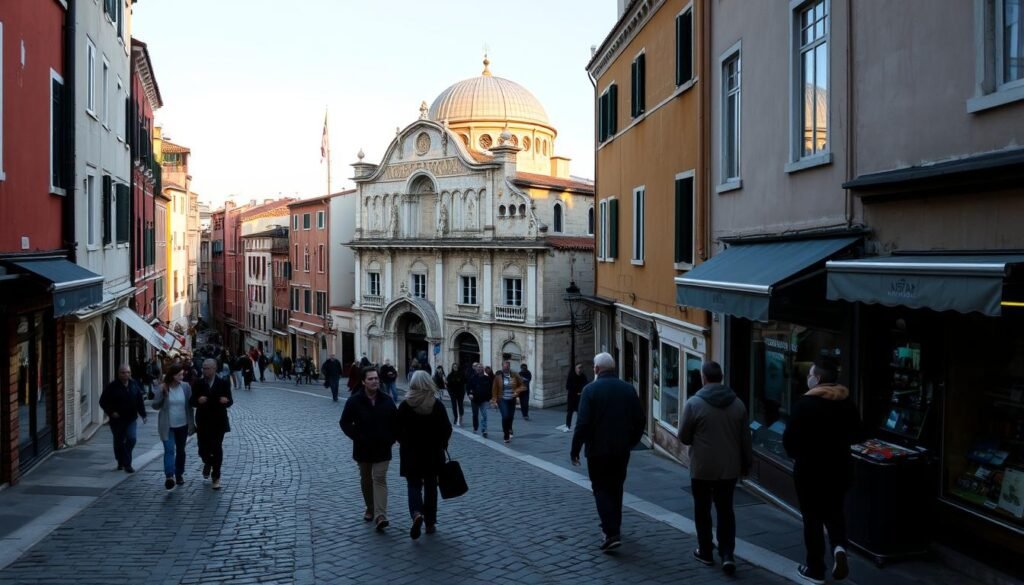
I slow my pace in Cannaregio, where the city breathes like a neighbor and not a postcard.
The Venetian Ghetto was created in 1516 and once had locked gates and curfews. Today it is a living neighborhood with several historic synagogues that offer guided or audio tour options for context and care.
I find Cannaregio calming because people move as if they are headed home, not just passing sights. I like a short loop along quiet streets and small canals where laundry and schoolyards tell everyday stories.
A combined neighborhood and tasting walk layers culture, food, and conversation in a compact area. Late afternoon into early evening is my favorite time; the light softens and local bars fill with slow chatter.
- I recommend visiting the synagogues respectfully: modest attire, low voices, and time to listen.
- Reach here from st. mark by vaporetto or on foot, then slow for sunset by a modest canal.
- Pop into low-key bacari for an ombra and cicchetti; I return to a couple of spots that feel comfortably local.
“A few unhurried hours here reset the rhythm of a whole trip.”
Venetian flavors: cicchetti bars, seafood, and the perfect spritz
I follow my nose from one bacaro counter to the next, sampling what locals favor. Small plates—cicchetti—are the heart of late afternoons here. I eat creamed cod (baccalà mantecato) on polenta, anchovy-topped bites, and seasonal fish when they appear on the counter.
Cicchetti I order and where I start
My go-tos: creamed cod, marinated anchovies, and a tiny seasonal skewer. I like beginning at Cantina Do Spade or a small bacaro near the market.
When a bar fills, I move on—two bites, one ombra (a small glass of wine), then slide to the next counter. That keeps the crawl lively and cuts wait time.
Spritz culture and choices
I explain the spritz spectrum quickly: Aperol is sweet and bright, Campari is bitter, and Select tastes most local. For balance, I order a mezzo e mezzo—half-and-half—and sip slowly as the light fades.
Restaurants, tours, and practical tips
For sit-down seafood I return to La Caravella or Ostaria Boccadoro for dishes like granseola and Venetian classics.
- If time is short, a guided tour saves trial and error and introduces makers I’d miss.
- Vegetarian and vegan options appear more often than expected near popular places.
- Budget tip: small plates add up—plan stops and savor each one rather than sampling everywhere.
These flavors anchor my memory of the trip long after I leave; they are the easiest way the city stays with me.
Rialto Market mornings: produce, spices, and the catch of the day

At dawn the Rialto Market wakes up like a painting—fish scales and vegetable greens catching the first light. The market has been a trading hub for over a millennium and still feels like the city‘s pantry.
I arrive early because stalls brim with color, fishmongers shout prices, and the soft canal light makes simple scenes glow. I usually start near the rialto bridge so I can frame a few classic shots before wading into the bustle.
If I have a kitchen later, I shop for seasonal produce, herbs, and fresh catch for a picnic or a home-cooked dinner. Small spice stands and pantry staples are easy suitcase souvenirs that remind me of the flavors I found here.
Watch the boats slide in and out as crates move fast—those minutes are the market at work. My sweet spot is within the first 90 minutes after opening; by late morning the crowd swells and the rhythm changes.
I finish with a short loop to nearby bacari for an espresso and a small bite while the city warms up. A quick etiquette note: step aside when sellers are packing so pros can keep moving and let others shoot pictures.
These bright, brisk market minutes always make me feel connected to daily life here.
Libreria Acqua Alta: rescuing books and climbing the paper staircase
I push open a narrow door and step into a maze where water and paper politely share the same space.
Libreria Acqua Alta protects books from high water by storing them in gondolas, bathtubs, and crates. The shop feels lived-in: a gondola piled with volumes at the center, small rooms that form a warren, and a few calm cats that wander the aisles.
The rear courtyard holds an Insta-famous staircase made of old books with a peek over the canal. Go early, be patient, and let others take a quick photo before you step up. I set a short time limit on busy days so I don’t lose an hour here.
- Buy light mementos: vintage maps, slim paperbacks, postcards, or a tiny print that will travel home easily.
- Walk the canal loop out back to watch light and reflections against brick walls.
- Be gentle with stacks—these volumes are working stock, not props.
| Feature | Best time | Why it matters |
|---|---|---|
| Book staircase | Early morning | Fewer lines and cleaner photos |
| Warren rooms | Any quiet hour | Find secondhand treasures and small art |
| Canal courtyard | Late afternoon | Soft light and calm reflections |
This place always gives me a small, stubborn proof that the city is more than a postcard; it holds stories that survive the tide.
Day trips I love: Burano’s colors and Murano’s glass
A short ferry ride opens a quieter chapter of the lagoon where color and craft take the lead.
My usual plan is clear: morning on Murano for a glass demonstration, then onward for a long, bright walk around Burano’s painted streets. The ferry from the main city takes about 45 minutes and links both islands on the same line.
Burano: bright facades and a leisurely island walk
Burano feels like a visual reset—wide canals, soft breezes, and lace-making history. I arrive before midday for calmer cafés and easier photos, then pause on a low bridge with the camera down and breathe.
Murano: glassblowing heritage and meaningful souvenirs
I go early for a workshop demo, watch a craftsperson, ask questions, and pick a small piece that tells a story. Good choices: tiny glass animals, a pendant, or a trimmed lace detail that travels well.
- I watch ferry intervals and build buffer time so I don’t rush the return.
- Snack plan: pastries on Murano, gelato on Burano, and plenty of water on warm days.
- Confirm studio hours off-season so you don’t miss a favorite shop.
These islands expand the trip by showing two faces of local craft and color. For a practical guide I like this short primer on Visiting Murano and Burano.
“A morning demo and a long island walk reset my view of the lagoon.”
La Fenice behind the curtain: touring Venice’s “Phoenix” theater
Stepping into Teatro La Fenice, I meet an interior rebuilt from ashes that still holds a powerful hush. The hall’s soft blues and gilded boxes feel like a jewelry case lit from within.
Why I love this stop: it is a bit quieter than major landmarks and fits neatly into an afternoon or a rainy spell. The self-guided audio tour lets me linger at the royal box and then move on when I choose.
I remember standing in the royal box and watching the stage from a view most people never see. The gilt details shimmer and the blue boxes frame small groups with theater intimacy.
- Listen for rehearsals—sometimes music drifts from behind the curtain.
- Pair the visit with a slow coffee nearby rather than rushing back into the busiest squares.
- Note the Phoenix story; knowing it was rebuilt adds a soft echo to every flourish.
| Feature | Why I like it | Best time |
|---|---|---|
| Royal box | Rare perspective on stage and audience | Mid-afternoon |
| Interior decor | Gilded detail and soft blue boxes feel intimate | Any quiet hour |
| Audio path | Paces the visit so you can linger without losing time | Flexible |
This modest theater tour adds texture to a city most people only see from the water.
Sunset ritual: Rialto Bridge and along the Grand Canal
I arrive a bit early, pick a side of the bridge, and let the color build slowly over the water.
The rialto bridge frames domes that glow at golden hour. Boats of every kind thread the grand canal, and the scene shifts minute by minute.
When the bridge grows crowded, I pivot toward Ponte dell’Accademia for steadier views. A small perch on the railing gives cleaner sightlines and steadier photos without a tripod.
I step off and stroll along grand canal after the sun drops. Reflections warm, lights begin, and the city finds a softer voice.
- Arrive early, pick a side, and watch color build.
- If Rialto is full, head to Accademia for a quieter angle.
- After sunset, take the #1 short ride to feel lights ripple on the canal.
Mind footing on steep steps and tuck valuables when crowds gather. For photos, brace on a railing, use a low ISO, and favor wider lenses for steady shots.
The evening hush here resets my energy—boats become silhouettes, the light softens, and the city hums a different song.
One perfect day in the city on the water
I build one day around sunrise light, a good ride on the water, and slow food breaks.
Morning: I start at San Marco for a quiet basilica view, then ride the Campanile elevator right at opening. The early time gives clear light and thinner lines.
Mid-morning: I catch the #1 vaporetto for a canals ride and step off near Rialto. A short market spin and a light bite keep the pace easy.
Late morning: I take a Doge’s Palace tour and cross the Bridge of Sighs. That hour holds history and calm reflection.
Afternoon: I linger over a cicchetti lunch, sample small plates at two bars, and then spend an art hour at the Peggy Guggenheim terrace. I watch boats draw lines on the water and breathe.
Golden hour: I decide between Accademia or Rialto for sunset based on how the day feels. Then dinner in Dorsoduro or Cannaregio where people gather and the place hums softly.
Backups: if weather shifts I slip into Libreria Acqua Alta or La Fenice for a cozy alternate plan.
This plan lets one place lead to the next in the easy way I like to travel.
| When | Stop | Why |
|---|---|---|
| Sunrise | San Marco & Campanile | Quiet light, wide views |
| Mid-morning | #1 vaporetto & Rialto | Scenic ride, market bite |
| Afternoon | Guggenheim terrace | Art and canal calm |
| Evening | Accademia / Rialto & dinner | Golden hour and local food |
Conclusion
A final slow ride along the water often stitches my whole visit into a clearer memory.
I mix icons—St. Mark’s Basilica, Doge’s Palace, and the Grand Canal—with quiet calli, small bridges like the Rialto Bridge, and a calm gondola ride or vaporetto leg for perspective.
San Marco and St. Mark Square anchor my day; I arrive early or linger late at the bell tower for thinner lines and better light.
I book one meaningful tour, follow local rhythms for food, and steal time for art at the Guggenheim or La Fenice.
A day on the islands, people-watching along the canals, and quiet views by the water are the details I carry home. Pick one path, give it minutes, and let the city show its best.


